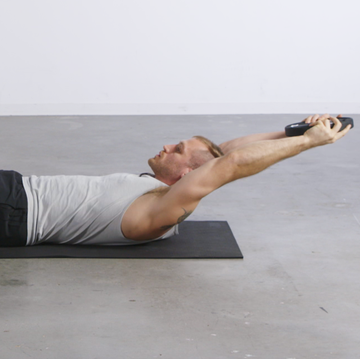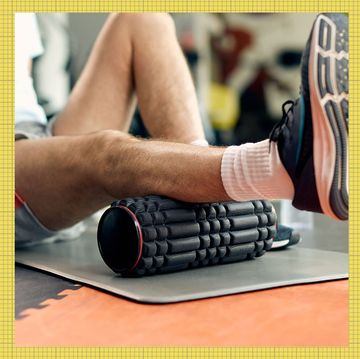You may not know it, but you have easy access to an extremely sophisticated, individualized training tool that can help you fine tune your workouts to lose fat, get stronger, faster and fitter.
Nope, we’re not talking about the latest wearable tech or fancy shoes. We’re talking about your heart. Specifically, your heart rate. Heart rate training isn't new, but it hasn't yet been totally embraced by common exercisers as a simple, effective way to help them achieve an entire spectrum of fitness goals.
We talked to two heart rate training experts, Bryant Walrod, MD, and Declan Connolly, PhD, about how to use their principles to lose weight, improve athletic performance and get the most out of your workouts.
“Heart rate training is using your heart rate response to gauge the intensity you’re working,” Connolly, co-author of Heart Rate Training: Increase Endurance, Raise Lactate Threshold, and Boost Power, and director of the Human Performance Lab at the University of Vermont, explained to Menshealth.com. “Anybody can benefit from heart rate training.”
Walrod, Assistant Professor of Clinical Family Medicine at The Ohio State University and team physician for the OSU Buckeyes, agreed. “Once you have an understanding of your own heart rate, there’s a lot of application, depending on your goals.”
Know Your Max
To begin heart rate training, you have to know the top end of your ticker's capacity: your heart rate max.
You might have heard of the old-school method for calculating your heart rate max — 220 minus your age. By that formula, if you're 25 years old, your max is 195 beats per minute (BPM).
However, both Connolly and Walrod agree that this method is oftentimes inaccurate, especially as age increases above 50. You need to know your heart rate max to use heart rate training principles in your workout—so here are some of the experts' favorite ways to calculate your score.
Method One: Max Heart Rate (MHR)
Connolly’s method involves actually getting your heart rate up as high as you can.
“A simple test that I have proposed over the years is going out onto an outdoor track, jogging 400 meters as a light warm-up, then running 400 meters as fast as you can,” Connolly said, “Repeat that entire sequence two more times, for a total of six laps (three jogging, three fast).
Check your heart rate right after the third set. Whatever that number is after the last lap is a good indication of your heart rate max.”
This might be unrealistic for some beginners or people who have injuries that prevent them from running, so sub out the laps for light work on a stationary bike or some other apparatus for two minutes, followed by hard work for a minute and a half. Use the same set structure Connolly recommends before checking your heart rate.
Method Two: Heart Rate Reserve (HRR)
If you're not up to hitting the track, you can also use Walrod’s technique. This way involves a bit more math, but a lot less sprinting. He suggests first using this formula for calculating your heart rate max: 208 - (.7 x age).
Our 25-year-old athlete from before, by this calculation, now has a max of 190.5 BPM.
“This formula tends to be more accurate [than 220 minus age] as you get older,” Walrod said.
Once you have your heart rate max, you need to find your resting heart rate. Do this by either counting your pulses for 30 seconds, then multiplying that number by two, or checking a heart rate monitor. It’s important to make sure you are sitting and completely relaxed when finding this number.
Next, use both of those numbers to calculate your heart rate reserve.
Heart Rate Reserve = (Max Heart Rate) - (Resting Heart Rate)
“As we get fitter, your resting heart rate will drop. If you’re consistent, your resting heart rate will change, so check in with that number at least annually,” Walrod advised.
Get In The Zone
To make your training effective, you should aim to get your heart rate up to a certain level during exercise—and keep it there. These ranges are commonly known as heart rate zones, and they have different potential benefits for your workout.
There are three main heart rate zones: aerobic/low intensity, anaerobic/moderate intensity, and anaerobic/high intensity. Using either your calculated heart rate max or your heart rate reserve (you’re able to use them interchangeably), determine each of the following numbers:
Aerobic/low intensity: 50-75 percent of MHR or HRR
Anaerobic/moderate intensity: 75-85 percent of MHR or HRR
Anaerobic/high intensity: 85 + percent of MHR or HRR
Fuel Yourself With Fat
One way to use heart rate training is for fat loss, specifically by optimizing the amount of fat your body is using as fuel. Contrary to what you may think, the optimal fat-burning zone is a relatively low intensity — specifically, 50-75 percent of HRR or MHR.
“This is the zone where your body is primarily using fat as a fuel source, rather than carbohydrates,” Walrod said. “Once you creep above that 75 percent, your body starts using carbs.”
Due to flawed logic, people often train too hard during their cardio bouts, hoping to burn fat quickly by pushing themselves as hard as possible. If improving your body composition is your goal, bring the intensity down and increase the length of working time.
“For optimal fat utilization, the sessions need to be a minimum 35 minutes,” Connolly explained. “The longer you’re able to maintain each individual session, the better."
For example, two 90-minute cardio sessions a week in the fat-burning zone will lead to greater overall fat utilization than four 45-minute sessions a week. The total time spent working out doesn’t change, even though the length of the individual sessions are longer.
Get Sporty
You can also use heart rate training to hone your athletic performance and overall level of fitness. Here are two proven methods the experts use with their athletes.
Method One: Improve anaerobic threshold
The first technique depends on increasing your anaerobic threshold, which is the point at which lactic acid starts building up in muscles and causes fatigue. Pushing that needle takes work and consistency.
“You need to find your steady-state rate, which is an intensity you can maintain for a prolonged period of time without your heart rate increasing,” Connolly said.
The test is simple. Find a moderately hard intensity for yourself on a cardio machine. Gradually increase the speed every one to two minutes, while monitoring your heart rate. The goal is to find a steady heart rate—a level at which you feel like you're working hard, but your heart rate doesn't jump up over the time you're training. This should be in that moderate intensity zone, about 75-85 percent of your HRR or HRM.
“Say your heart rate is at 130 BPM," Connolly said. "Stay at that intensity for three minutes. If, after three minutes, it remains unchanged, increase the intensity slightly and do the test again. If it starts to creep up after three minutes without changing the intensity, you need to slow down.”
To improve you anaerobic threshold, and thus overall fitness, do 40-45 minutes of steady-state cardio, two to three times a week. “After about four weeks, try increasing your intensity,” Connolly advised, “You’ll find that you’ll be able to work at a higher intensity while maintaining a steady-state heart rate.”
Method Two: Interval training
We’ve all heard of high-intensity interval training, or HIIT, which consists of bouts of near-maximal effort work followed immediately by rest. How effective it truly is, however, is largely dependent on how hard you push your heart.
“HIIT intervals should get you up to at least 85 percent of your heart rate reserve [during work periods],” Walrod said. “Then you should allow your heart rate to come all the way back down to 55-60 percent.”
Connolly cautioned that people should not even attempt HIIT training unless they’re already fairly fit and/or have 12-16 weeks of consistent training under their belt.
“If you’re not already fit, you will tire quickly and you will not be able to recover,” Connolly explained. “The workout will end end up defaulting to a low-intensity training session.”
Listen To Your Heart
“What I see most often is people are simultaneously working too hard and not hard enough,” said Walrod, who specializes in improving endurance performance.
“On the days that are supposed to be easy, closely monitor your heart rate and make sure it doesn’t come above 75 percent of your heart rate reserve,” Walrod continued. “And on your hard days, make sure you’re able to keep your heart rate up. You can’t do this if you’re fatigued from a previous ‘easy’ session that you went too hard on.”
Ultimately, the well-rounded athlete will get more out of their workouts by understanding their goals and how best to use their own internal tool to achieve them. There are no big secrets here, or anyone else you need to trust. Just listening to what their heart.















